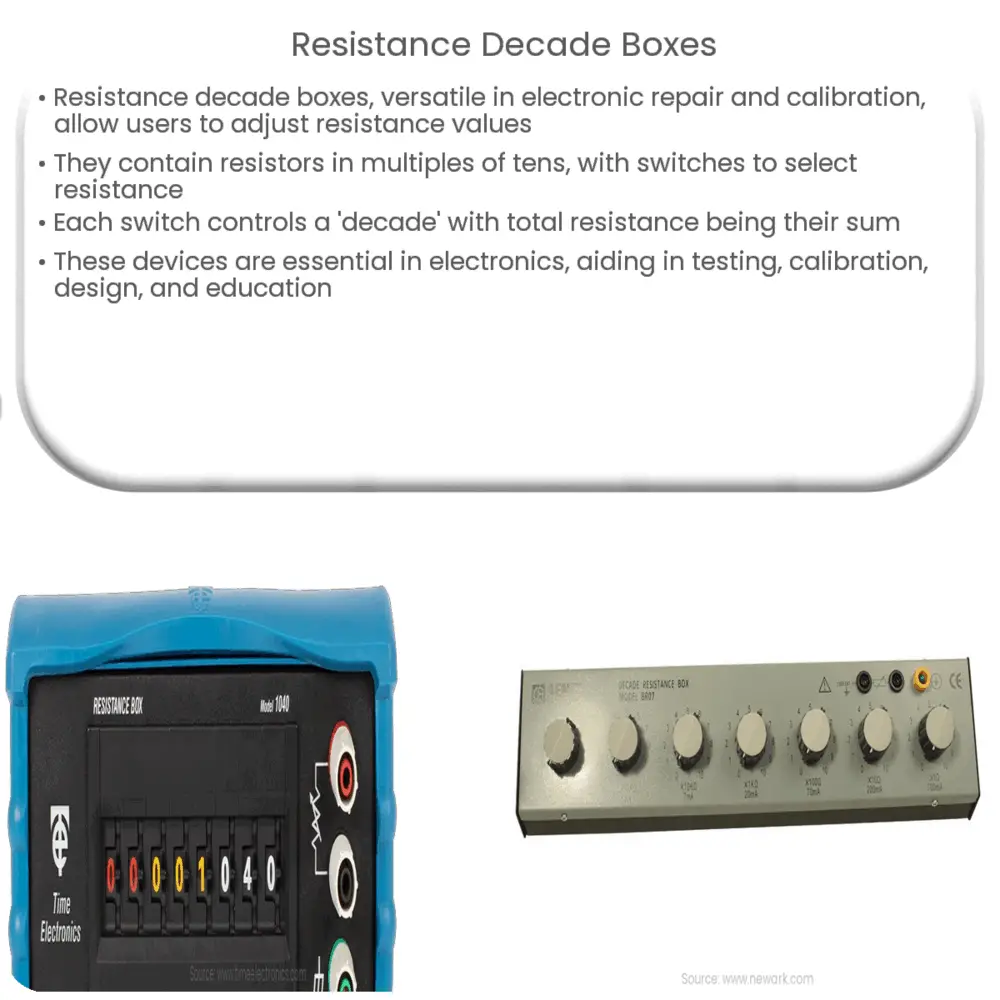Explore the fundamentals, applications, and types of Resistance Decade Boxes, essential tools in electronic testing and calibration.

Introduction to Resistance Decade Boxes
Resistance decade boxes, also known as resistor substitution boxes, are versatile devices used in a variety of settings including electronic repair, calibration, design and teaching. These devices offer a simple and effective means to select and adjust resistance values within a circuit.
Understanding the Fundamentals of Resistance Decade Boxes
A resistance decade box is essentially a type of electronic test equipment that contains resistors of many values, with switches in front to select the desired resistance. The name ‘decade’ comes from the fact that the switches are usually organized in powers of ten, i.e., units, tens, hundreds, thousands (kilo-ohms), and so forth.
Components of a Resistance Decade Box
-
Resistors: The primary component of a resistance decade box is the set of resistors. These are arranged in a series of ‘decades’ which allows the user to dial in a specific resistance value.
-
Switches: The switches in the box are used to select the resistance value. Each switch corresponds to a decade, and the value of resistance can be chosen by adjusting these switches.
-
Terminals: These are the points where the box connects to the rest of the circuit. The resistance value selected via the switches is applied across these terminals.
Working Principle of a Resistance Decade Box
Each switch on the box controls a decade. By changing the position of a switch, a user changes the resistance of that decade. Each decade is connected in series, so the total resistance is the sum of the resistance from each decade. For example, if a box has four decades labeled ‘units’, ‘tens’, ‘hundreds’, and ‘thousands’, and the switch settings are 2, 3, 4, and 5 respectively, then the total resistance will be 2 + 30 + 400 + 5000 = 5432 Ohms.
These devices provide an easy way to dial in an exact resistance value, which can be critical in many testing and calibration scenarios. Their precise nature and ease of use make them an invaluable tool for electronic engineers and technicians alike.
Applications of Resistance Decade Boxes
Resistance decade boxes find use in a wide range of applications:
-
Testing and Calibration: These devices are used to test electronic components such as sensors, meters, or any other devices that require resistance for proper operation. They are also used for calibration of measurement instruments.
-
Design and Prototyping: In electronic design and prototyping, resistance decade boxes can be used to simulate different resistive loads or inputs.
-
Education: These are excellent tools for teaching electronics, particularly the concepts of resistance, Ohm’s Law, and circuit analysis.
Types of Resistance Decade Boxes
There are various types of resistance decade boxes based on the level of precision, resistance range, and type of resistors used:
-
Standard Resistance Decade Boxes: These are the most common type and offer a wide range of resistance values.
-
Precision Resistance Decade Boxes: These are designed for high-accuracy applications, often used in calibration labs.
-
High-Resistance Decade Boxes: These boxes offer very high resistance values, typically in the range of Mega to Giga ohms.
-
Low-Resistance Decade Boxes: These boxes, on the other hand, offer very low resistance values, often down to milliohms.
Conclusion
In summary, resistance decade boxes are an essential tool in the field of electronics. They offer a simple, precise, and adjustable means to select and control resistance values within a circuit. With applications spanning from testing and calibration to design, prototyping, and education, these devices prove to be versatile and invaluable. Understanding the functionality and utilization of resistance decade boxes is key for anyone involved in electronics, be it a professional engineer, a technician, or a student learning the basics of electronic circuitry.

